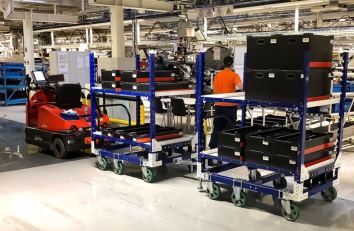Material Handling Ergonomics Support Occupational Health and Safety
ProMat 2019 is in the rearview mirror. Some exciting and interesting products and automation breakthrough technologies were introduced during the MHI event. Back on the manufacturing plant floor and warehouse distribution center floor are real issues of occupational health and safety (OH&S).
More than regulatory compliance, most material handling ergonomic and safety professionals are totally committed to decreasing the occurrence of injuries. OH&S experts recommend designing the job to fit the employee or simply adopting ergonomics in the workplace. The National Institute for Occupational Safety and Health (NIOSH) suggests methods how to improve ergonomics in material handling. From improving work processes to reducing injury and promoting productivity there is always room for improvement.
Too often there is excessive manual lifting, lowering, filling, or emptying containers. There are better tools (equipment) that minimize manual lifting and material handling. Ergonomic equipment includes rotating carts, tilt carts, and custom kit carts.
The quality and safety functions are always a blend of management and employees working together to create and use safe policies that improve work habits. There is not a single solution, but some practical solutions include job rotation among employees. Employees shift between different jobs or workstations at specific time intervals. The variety of tasks increases as the employee performs more duties.
When there is a labor shortage (unemployment remains consistently below 4 percent), keeping employees engaged is far easier if boredom and sloppy work habits are avoided. Job rotation is a well-planned practice to reduce the boredom of doing same type of job every day and explore the hidden potential of an employee. The process serves the purpose of both the management and the employees. It helps management in discovering the talent of employees reinforcing best safety practices.
Ergonomic Training and Work Area Design
Management must also ensure that the employees are trained on the proper lifting, material handling techniques, and equipment. Every decision made by employees during a work shift must include ergonomic considerations.
Improving the design of the work area is the preferred method of lowering risk for injury. The layout and organization make it possible for materials to be handled without needing to bend, twist, or stretch excessively. By incorporating ergonomics in the layout of the work area, fundamental health and safety principles can be incorporated. Simple kaizen events can corroborate that all materials are positioned at work level and adjustable. A workbench should have an adjustable height and tilt to improve the employee's working position.
Similarly, there must be enough space to turn around to avoid twisting the body. Adjustable suspenders or support should be available when operating heavy tools. This decreases muscular effort and pressure exerted on the back.
Reducing Injury and Increasing Productivity
The potential for reducing injury related costs alone makes ergonomic interventions a useful tool for improving a company's productivity, product quality, and overall business competitiveness. Often, productivity gets an additional and solid shot in the arm when managers and workers take a fresh look at how best to use energy, equipment, and exertion to get the job done in the most efficient, effective, and effortless way possible.
Ergonomics, Moving Toward Fork Truck Free
 Ergonomics in material handling focuses on the prevention, not treatment, of work-related injuries. It aims to eliminate fatigue and discomfort before the employee experiences a painful musculoskeletal disorder.
Ergonomics in material handling focuses on the prevention, not treatment, of work-related injuries. It aims to eliminate fatigue and discomfort before the employee experiences a painful musculoskeletal disorder.
Tow tractors with heavy-duty carts are now widely used to move materials efficiently. Even companies that are hesitant to give up forklifts at first are now using tugger trucks as they gently move toward a fork truck-free environment.
Both manned and unmanned trucks have proven to be more efficient, more cost effective, and more productive. Most importantly, they are also more ergonomic and more flexible to use than the traditional forklifts.
Andy Legut is the Midwest Sales Manager for FlexQube, Inc. and the longest running North American employee for FlexQube. He has years of experience working alongside different manufacturing facilities and providing ergonomic, efficient, and safe FlexQube solutions. Legut is from Grosse Ile, Mich. (not far from Detroit), so he has grown up with the automotive industry in his blood. He can be reached at 734-624- 2121 or [email protected].
Posted on Apr 26, 2019